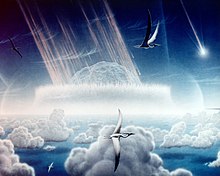Chicxulub impactor

The Chicxulub impactor (/ˈtʃiːkʃəluːb/ CHEEK-shə-loob), also known as the K/Pg impactor and (more speculatively) as the Chicxulub asteroid, was an asteroid or other celestial body some 10 to 15 kilometres (6 to 9 mi) in diameter[3][4] which struck the Earth at the end of the Cretaceous period, approximately 66 million years ago,[5] creating the Chicxulub crater. It impacted a few miles from the present-day town of Chicxulub in Mexico, after which the impactor and its crater are named. Because the estimated date of the object's impact and the Cretaceous–Paleogene boundary (K–Pg boundary) coincide, there is a scientific consensus that its impact was the Cretaceous–Paleogene extinction event which caused the death of most of the planet's non-avian dinosaurs and many other species.[6][7]
The impactor's crater is over 150 kilometres (93 miles) in diameter[8] making it the second largest known impact crater on Earth.
Parent body
There are several competing models for the impactor's origin and its relationship to other asteroids that still exist in the Solar System. In September 2007, William F. Bottke, David Vokrouhlický, and David Nesvorný proposed an origin for the impactor in an article published in Nature. This argued that a collision in the asteroid belt 160 million years ago resulted in the Baptistina family of asteroids, the largest surviving member of which is 298 Baptistina. They proposed that the Chicxulub impactor was an asteroid member of this group, referring to the large amount of carbonaceous material present in microscopic fragments at the site, suggesting that it was a member of a rare class of asteroids called carbonaceous chondrites, like Baptistina. According to Bottke, the Chicxulub impactor was a fragment of a much larger parent body about 170 km (110 mi) across, with the other impacting body being around 60 km (40 mi) in diameter.
However, in 2011 new data from the Wide-field Infrared Survey Explorer revised the date of the collision which created the Baptistina family to about 80 million years ago, casting doubt on the hypothesis, as typically the process of resonance and collision of an asteroid takes many tens of millions of years.[9]
Other work has associated the asteroid P/2010 A2, a member of the Flora family of asteroids, as a possible remnant cohort of the Chicxulub impactor.[10]
See also
References
- ^ Nicholas M. Short, Sr., Crater Morphology Some Characteristic Impact Structures at nasa.gov, accessed January 2013
- ^ The article by Nicholas M. Short, Sr. appears to have moved, but the image above does not appear to have moved with it. See Crater Morphology Some Characteristic Impact Structures at fas.org, Accessed December 9, 2015.
- ^ Sleep, Norman H.; Lowe, Donald R. (9 April 2014). "Scientists reconstruct ancient impact that dwarfs dinosaur-extinction blast". American Geophysical Union. Retrieved 30 December 2016.
- ^ Amos, Jonathan (15 May 2017). "Dinosaur asteroid hit 'worst possible place'". BBC News Online. Retrieved 16 March 2018.
- ^ "Dinosaur extinction: Scientists estimate 'most accurate' date". BBC News. Retrieved 2015-10-28.
- ^ "International Consensus — Link Between Asteroid Impact and Mass Extinction Is Rock Solid". www.lpi.usra.edu. Retrieved 2015-10-28.
- ^ Schulte, Peter (March 5, 2010). "The Chicxulub Asteroid Impact and Mass Extinction at the Cretaceous-Paleogene Boundary" (PDF). Science. 327: 1214–8. Bibcode:2010Sci...327.1214S. doi:10.1126/science.1177265. PMID 20203042. Archived from the original (PDF) on June 25, 2015. Retrieved 2015-06-25.
{{cite journal}}: Unknown parameter|deadurl=ignored (|url-status=suggested) (help) - ^ "Chicxulub". Earth Impact Database. Planetary and Space Science Centre University of New Brunswick Fredericton. Retrieved December 30, 2008.
- ^ Tammy Plotner, Did Asteroid Baptistina Kill the Dinosaurs? Think other WISE... in Universe Today (2011) at universetoday.com
- ^ "Smashed asteroids may be related to dinosaur killer" Reuters, February 2, 2010


